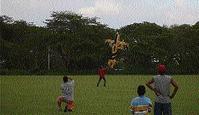Anthea McGibbon, Gleaner Writer
Air Jamaica's pilot Mark West tries to touch the tail of the hovering XTRA330L aircraft. - Contributed
Complementing the world of painters, Jamaicans over the Easter weekend demonstrated other artistic abilities. At the Kingston Polo Club, with the sky as a limitless canvas, a few artists manoeuvred aerobatics, while patrons were kept Ahead of Time at Harmony Hall, Ocho Rios, by skilled craft vendors.
Graphic artist, Gordon Williams, is one who takes his technical skills to the limits of the sky. He joined other members of the Flying High Club in demonstrating the flight performance of miniature aircraft (including jets, propeller-driven aircraft, glider) and helicopters - some of which have been built and decorated locally.
In the delicate art of flying radio- controlled model aircraft, precision is key and, thankfully, a few Jamaicans have mastered this technical area. Along with Williams, professionals including the police, videographers, telecommunicationists, fine artists, air conditioners, engineers and career pilots made gigantic art across the sky.
Intricately crafted from mostly balsa wood and/or composite material (fibreglass and carbon fibre and styrofoam) the aircraft were a beauty to watch as the 'big boys' manoeuvred their aerobats from beneath. The aircraft were flown sometimes beyond 1500 feet, e.g. in the Climb and Glide segment of the day's events.
Influenced by the various disciplines, the pilots revealed the true character of the aircraft they had gotto explore intimately. According to Mark West, the more mechanically inclined persons gravitated towards helicopters and jet-propelled aeroplanes, which are technically more challenging.
Much attitude
There was much attitude in the sharp turns, nose dives, rolls and loops from the models with travelling speed ranging from 30 to and beyond 220 miles per hour there was no formation flying, there was sufficient creativity and distinguished style in individual strokes across the sky.
At the end of each performance, viewers gasped as if seated in the miniature-scaled aircraft and wondering how smooth the landings would be. Apart from a few bumpy landings, evidently there is a handful of Jamaicans who know how to land in fine style.
The main attraction of the day was the performance by the F18 hornet, owned and piloted by David Yapp. Yapp's F18 hornet model is an approximate 1/7th scale of the actual fighter jets used in the United States Airforce.
Another main highlight was the special sequence of aerial ballet by the XTRA330L, owned and flown by Air Jamaica pilot Leighton Henry. The actual life-sized XTRA 330L, as explained by commentator Steve McGrath, is built specifically for precision aerobatics. However, in the miniature models these features are mimicked and enhanced.
Henry, with his 40 per cent scaled replica performed a typical routine often required in international competitions. Included in these graceful jots across the open sky were inverted flying, prancing, waterfalls and a level descending manoeuvre called the 'elevator'. At times the nose was angled at 45 degrees, to the delight of viewers. At one point, Henry hovered the 40-pound, twin-cylinder, two-stroke engine plane on its tail, and at his command, the plane stood upright in mid-air waiting for the touch of a member of 'Team Jamaica'.
Eyes closed or not, McGrath's commentary was enough imagery to transcend one into the clouds as the aircraft hissed, buzzed and hummed the tunes of their life-sized counterparts.
Among the challenges faced are keeping the wings levelled during aerobatics manoeuvres (as a 10-degree deviation would result in the loss of points in a competition) and manipulating the craft, especially the helicopters with the engines off (i.e. auto rotation) in order to secure a safe landing. A fine lesson for the pilot facing such real emergencies.
For the precision and manoeuvring flights, up to 100 flights might be necessary to get the aircraft fully adjusted for flying accurately enough for competition.
The art of flying model planes has been in existence in Jamaica for over 40 years. The eventful day of limbos, pylon racing spot landing, climb, glide and precision aerobatics was a good start to understanding the art of flying. Michael Brown, a model flyer enthusiast from Florida was present to discuss his current plans for an international air show here, where representatives from international clubs are already confirmed.

